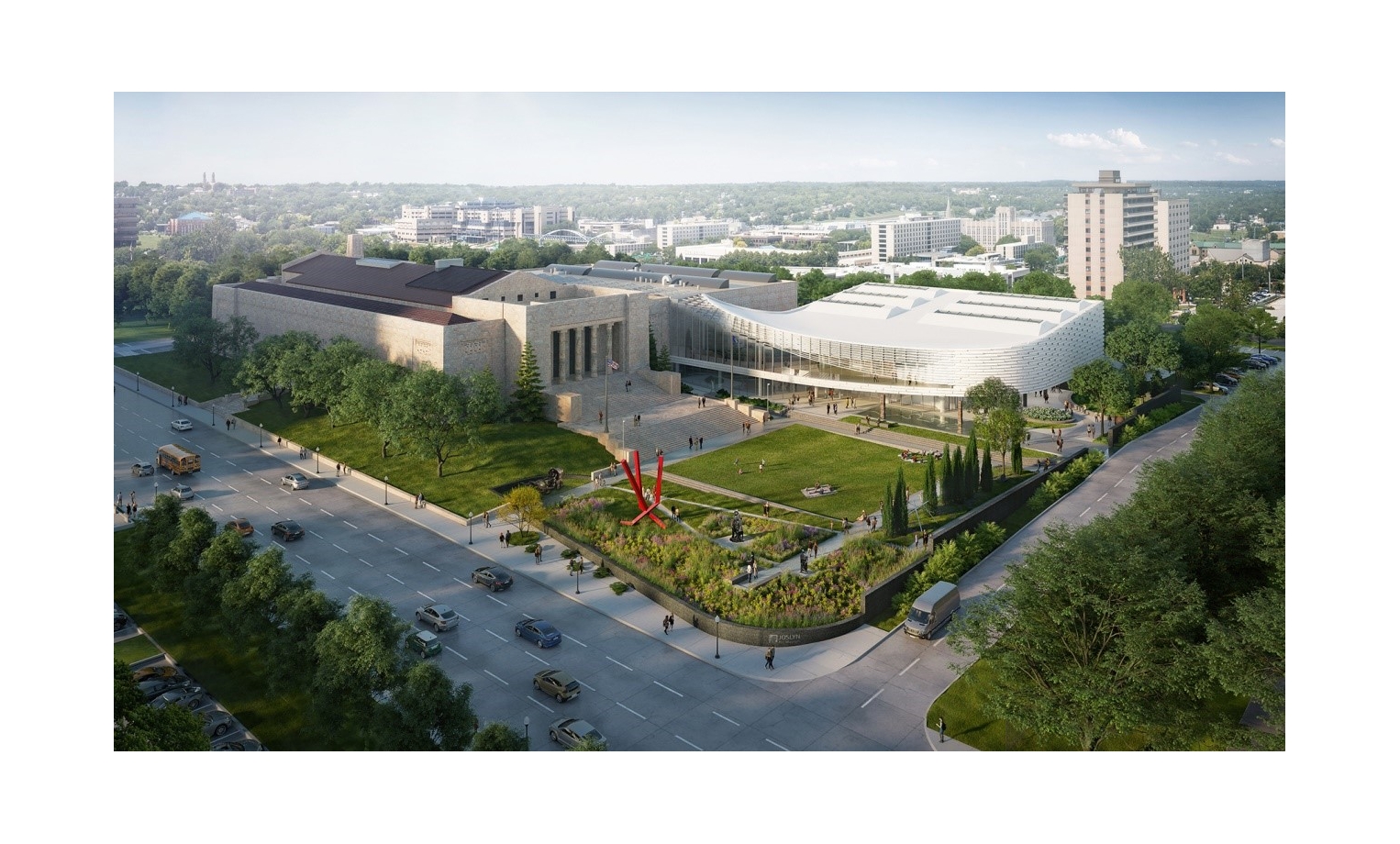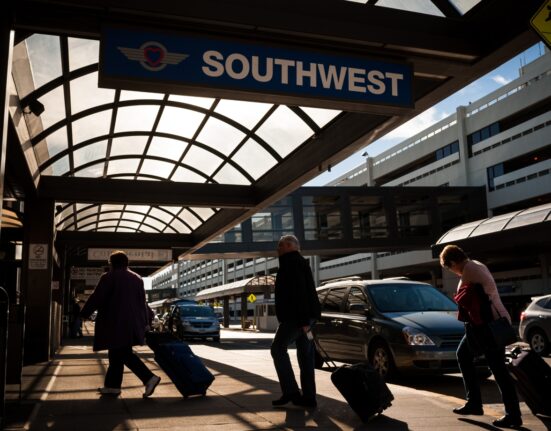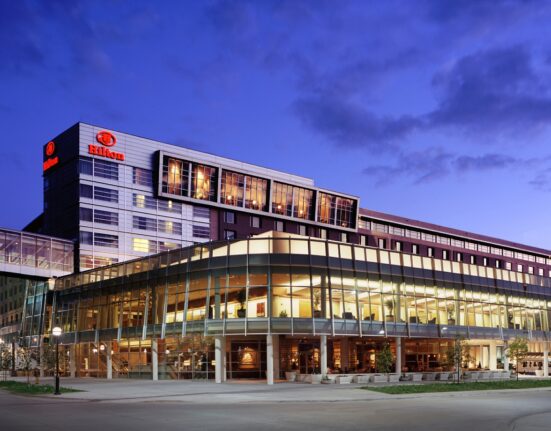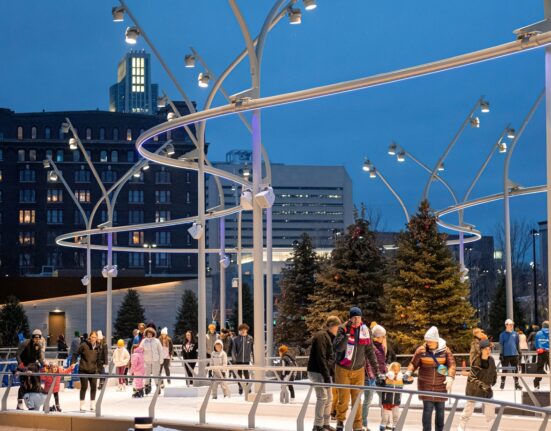(Omaha, NE) – Today at a ceremonial groundbreaking, Joslyn Art Museum executive director & CEO Jack Becker unveiled the design for the Museum’s expansion and renovation, led by international architectural firm Snøhetta in partnership with Omaha’s Alley Poyner Macchietto Architecture (APMA). The new building will be named for Rhonda and Howard Hawks of The Hawks Foundation.
Pictured Above:Joslyn Art Museum New Pavilion Expansion, Aerial View. Rendering courtesy Moare.
Scope of Project
Central to the 42,000-square-foot Rhonda and Howard Hawks Pavilion are abundant light-filled galleries designed to meet the demands of and explore the possibilities of a growing permanent collection. Visitors will find new community spaces, additional classrooms, and enhanced amenities that support increased public programs. In addition to the new galleries and public spaces, the architectural team will restore and modernize existing office spaces in Joslyn’s 1931 Memorial Building. The project also redesigns and rejuvenates more than three acres of public gardens and outdoor spaces on the Museum site. The site work includes a reorientation of the grounds around a reimagined point of public arrival anchored by an atrium named for Phillip G. Schrager.
In the new gallery spaces, the public will have unprecedented access to works from the nationally-renowned Phillip G. Schrager Collection of Contemporary Art. The Museum received a transformative gift of over fifty works from that collection, instantly propelling Joslyn to a new position on the international museum stage and greatly expanding the range of twentieth-century artists represented in its collection.
Architectural History
Nebraska’s largest art museum first opened its doors in 1931 with the iconic Joslyn Memorial Building. Designed by father-son architectural team John and Alan McDonald, the Joslyn Memorial was a gift to the city of Omaha from Sarah Joslyn in memory of her husband, George. Over its 90-year history, Joslyn Art Museum has remained committed to a public-facing mission, with free admission for all, and stands among the most important cultural institutions in Omaha and the region at-large. Its architectural heritage is no less significant. The original Memorial Building, clad in vibrant Georgia Pink marble and regarded as one of the finest historical examples of the Art Deco style, found its distinctly modern counterpart in Lord Norman Foster’s 1994 expansion—the Scott Pavilion—the architect’s first built project in the United States. In 2009, two new sculpture gardens further expanded Joslyn’s exterior spaces for art, adding much-needed outdoor experiences.
Vision for Expansion
Snøhetta and APMA’s design for the new Rhonda and Howard Hawks Pavilion expands Joslyn’s existing gallery space by more than one third and introduces intertwined indoor and outdoor art experiences and a new public arrival drive and entrance. The expansion building springs from the current glass atrium as a curving, low-slung volume that gradually twists from glass to solid, transforming the existing atrium’s horizontal skylights into solid, vertical walls that hold the Pavilion’s new day-lit galleries on the second floor. Complementing Joslyn’s existing iconic buildings, the new building appears as a solid, floating volume set lightly atop two granite garden walls, with a transparent first floor enclosing a new atrium lobby, Museum shop, and multi-function community space. These ground floor spaces gradually rise to the level of the existing buildings via a gently sloping, accessible walkway. The weightless effect of the hovering expansion recalls the striking cloud formations that blanket the Great Plains as well as the deep overhangs and horizontal expression of regional Prairie Style architecture. The horizontal texture of the new façade takes its cue from the stacked stone steps of the Memorial Building’s monumental Grand Staircase that emerge from the east side of the existing buildings in parallel with the expansion. The façade’s light-colored, precast panels are embedded with vibrant pops of pink aggregate that reflect the rich, rose-colored marble of the existing buildings.
When the expansion is complete, experienced visitors to Joslyn Art Museum will immediately notice important changes to the grounds that clarify their arrival and increase the connectivity between existing spaces. The primary access to Joslyn has been relocated to the northern edge of the site, off Davenport Street, leading to a revitalized entrance drive that sits on axis with a new, raised sculpture garden and Museum entrance, creating a clear sense of front and a new beginning for the Museum experience. The expansion relocates the front door, from its more hidden location inside the existing glass atrium to the edge of the entrance drive. In inclement weather, Museum visitors may take advantage of the new covered drop-off area sheltered from the elements by the galleries cantilevered overhead. New sculpture gardens have been reimagined as a sweeping collection of landscaped spaces and outdoor “rooms” that wrap the site, weaving the buildings and outdoor spaces together around a spine formed by the existing installation The Omaha Riverscape by sculptor Jesús Moroles. At the southeast corner of the site on Dodge Street, the existing retaining wall has been lowered to reveal the Memorial Building and its Grand Staircase to those approaching Joslyn from the east, a change complemented by a new Great Lawn framed by native grasses and vibrant meadow plantings creating colorful variation throughout the seasons. The existing Discovery Garden is reconnected to the Museum and other gardens by a new landscape for pedestrians with paths that reveal sculptures and native plantings along the way. Honoring Joslyn’s identity while opening a more porous, inviting front, the expansion marks a new chapter in the Museum’s vision for public access to the arts through a comprehensive redesign. The galleries showcase a range of art new to the Museum while allowing for increased public access to more works from Joslyn’s collections of 3,000 years of art, including Native American objects and works on paper. New classrooms and public spaces support greater breadth and depth of public programming and art education. The expansion builds upon Joslyn’s rich history as an iconic landmark and cultural hub as it creates a dynamic, inclusive design that is open to all.
Site work for the expansion has begun and construction will occur in phases. For the safety of visitors, staff, and the art, the Museum will undergo a necessary period of closure beginning May 2022 through reopening in 2024. While temporarily closed to visitors, Joslyn staff will continue its curatorial and research work while exploring new possibilities for engagement with the community leading up to reopening.







Leave feedback about this